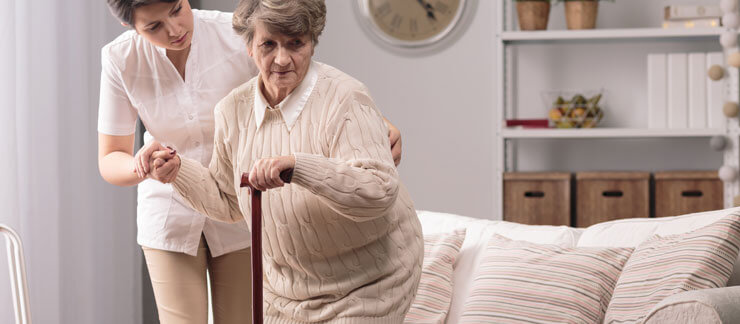
What to Know About Fractured Hips Among the Elderly
Millions of older Americans fall every year. The CDC reports that more than one out of four seniors fall annually. Of those, 3 million have to visit an emergency department and over 800,000 are hospitalized. In 2015 the cost of treating these injuries was more than $50 billion, of which Medicare and Medicaid paid 75 percent. Perhaps most worryingly, the CDC further reports that deaths from falls are on the increase, having risen 30 percent since 2007.
If your loved one has suffered a fall, there are a range of outcomes. With luck, all that's bruised is pride, but seniors are usually more delicate than the general population, and one in five falls results in a severe injury, such as broken bones or head injury. One specific injury that's often a result of a senior fall is a hip fracture. Over 300,000 seniors are treated for hip fractures every year, and 95 percent of hip fractures arise from a fall.
Risk of Hip Fracture Greater in Women
If one of your parents suffers a hip fracture, statistically it’s more likely to be Mom. Women’s bones weaken after menopause due to decreased estrogen levels and broken bones become an inherent risk. In fact, 70-75 percent of hip fractures occur in women.
Symptoms
If your loved one falls and you suspect a broken bone, you'll naturally get him or her to an emergency room as quickly as possible. But if your loved one has suffered a fall and you’re unsure if it merits a hospital visit, the Mayo Clinic advises you look for symptoms including:
- Inability to move
- Severe pain in the hip or lower back
- Inability to put weight on the injured side
- Bruising and swelling around the hip
- Shortening of one leg
Diagnosis
Once you seek treatment, either at an emergency room or from another physician, a doctor will most likely order x-rays. The Cleveland Clinic points out that small hairline fractures may not show up well in x-rays, in which case the doctor may have to order an MRI.
The doctor will identify from the x-ray or MRI where the break is. The hip is a ball and socket joint between the pelvis and the femur. Most hip fractures are on the femur, which is the long bone at the top of the leg, sometimes called the thigh bone.
Treatment
Treatment for a hip fracture usually involves some kind of surgery, medication and a period of rehabilitation. The Mayo Clinic points out that the most suitable surgery often depends on many factors. Available operations may include internal repair using screws, a total hip replacement or a partial hip replacement.
Rehabilitation
Sadly, half of older people who suffer a hip fracture will never be as active or independent as they were before. Rehabilitation will usually consist of physical therapy, to increase motion and strengthen the joint, and occupational therapy to build independence and help relearn how to walk, wash, use the toilet and deal with everyday life. A walker or wheelchair may be required.
The Additional Costs of a Hip Fracture
The cost of a hip fracture can be estimated in different ways. Ten percent of seniors who have a hip fracture will have another one within two years. Regarding life expectancy, people who have a hip fracture live 1.8 years less on average than people who don’t. In older people around 20 percent of patients pass away within a year of having a hip fracture.
The lifetime financial cost of a hip fracture is estimated to be $81,300, of which 44 percent relates to nursing costs. Approximately 20 percent of those who have a hip fracture will require some form of nursing home stay.
A loved one's hip fracture can be an overwhelming financial burden on both your loved one and your family. Learn more about the costs of falls by clicking here.
How Home Care Can Help
A nursing home stay is not an inevitability though. With some help, your loved one may be able to stay in her own home. After surgery, your mom will most likely need help with every part of her day-to-day life. She may need help to get up in the morning, to get dressed, to bathe and go to the restroom, and to cook and keep the house clean. While family members may be able to help with some of these needs, it's worth considering if a trained professional caregiver may be able to help in her rehabilitation.
Professional caregivers should have experience dealing with seniors who have the same needs as your mom. They can help with personal needs such as hygiene, housekeeping needs like cooking and light cleaning, and most importantly allow her to rehabilitate in the comforting surroundings of home instead of a hospital. Home care providers should match your loved one with a caregiver who has experience in meeting her specific needs. The caregiver will know about her issues and help to motivate her, keep her spirits up and aid in her rehabilitation in any way possible.
Most importantly, because of a hip fracture's high incidence of re-occurrence and the frightening statistics about the possible outcomes, a professional caregiver who is trained in fall prevention can help to fall-proof your loved one's home. These professionals can encourage lifestyle choices that will minimize fall risk and be around when your loved one needs them, to hopefully prevent future falls and injuries.
Prevention is always better than cure. For 10 critical safety tips to fall-proof your aging parent’s home, click here.
